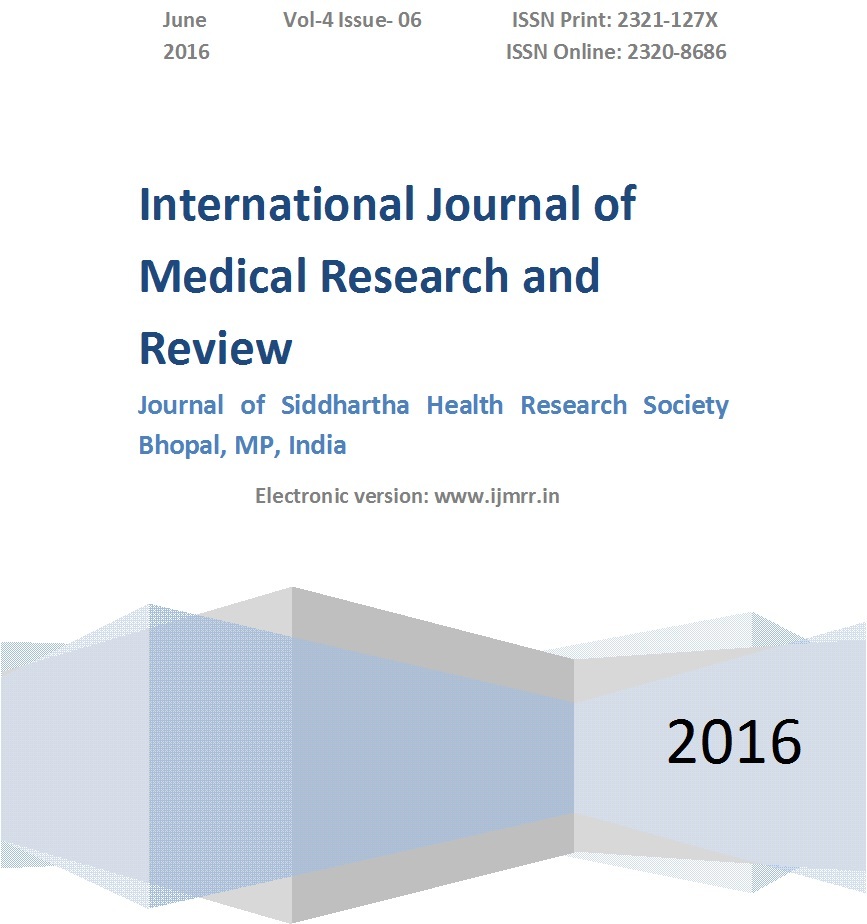Lacrimal syringing versus combined lacrimal probing and syringing for treatment of congenital nasolacrimal duct obstruction in children
Abstract
Introduction: Congenital nasolacrimal duct obstruction (CNLDO) is the most common abnormality of the lacrimal system in the early years of life.
Aims and Objectives: To rationalize the applicability of lacrimal syringing alone in comparison to combined lacrimal probing and syringing for the treatment of congenital nasolacrimal duct obstruction in children.
Material and Methods: The study was conducted on fifty patients suffering from congenital nasolacrimal duct obstruction randomly selected from the outpatient department of Regional Institute of Ophthalmology, Government Medical College, Amritsar.
Results: Majority of cases could be cured by single attempt of combined probing and syringing and cure rate could be enhanced by repeated attempts within 1st two years of life.
Conclusion: The overall assessment of the study indicates that although the success rate of gentle lacrimal syringing alone is low yet it is worthwhile to try this least traumatic procedure in each and every child reporting with congenital nasolacrimal duct obstruction under 1 year of age. If lacrimal syringing as a first hand procedure fails, then lacrimal probing along with syringing should preferentially be attempted and may be repeated 2-3 times at a minimum interval of 2 weeks each till the patency of nasolacrimal duct is restored.
Downloads
References
2. Bashour M. Nasolacrimal duct, congenital anomalies. eMedicine. June 2009.
3. Riser RO. Dacryostenosis in children. Am J Ophthalmol. 1935;18:116.
4. CASSADY JV. Dacryocystitis of infancy; a review of 100 cases. Arch Ophthal. 1948 Apr;39(4):491-507.
5. GUERRY D 3rd, KENDIG EL Jr. Congenital impatency of the nasolacrimal duct. Arch Ophthal. 1948 Feb;39(2):193-204.
6. Ffooks OO. DACRYOCYSTITIS IN INFANCY. Br J Ophthalmol. 1962 Jul;46(7):422-34.
7. Nucci P, Capoferri C, Alfarano R, Brancato R. Conservative management of congenital nasolacrimal duct obstruction. J Pediatr Ophthalmol Strabismus. 1989 Jan-Feb;26(1):39-43.
8. NORDLOW W, VENNERHOLM I. Congenital atresiae of the lacrimal passages: their occurrence and treatment. Acta Ophthalmol (Copenh). 1953;31(4):367-71.
9. Cha DS, Lee H, Park MS, Lee JM, Baek SH. Clinical outcomes of initial and repeated nasolacrimal duct office-based probing for congenital nasolacrimal duct obstruction. Korean J Ophthalmol. 2010 Oct;24(5):261-6. doi: 10.3341/kjo.2010.24.5.261. Epub 2010 Oct 5.
10. Robb RM. Success rates of nasolacrimal duct probing at time intervals after 1 year of age. Ophthalmology. 1998 Jul;105(7):1307-9; discussion 1309-10.
11. BROGGI RJ. The treatment of congenital dacryostenosis. AMA Arch Ophthalmol. 1959 Jan;61(1):30-6.
12. Traquair HM. Chronic dacryocystitis. Arch Ophthalmol.1941;26(2):165-180. d.0.i: 10.1001/archopth. 1941. 00870140015001.
13. Bouzas A. Congenital nasolacrimal atresia in infants--a higher incidence in primiparas. Ophthalmologica. 1974;168(5):360-5.
14. KOKE MP. Treatment of occluded nasolacrimal ducts in infants. Arch Ophthal. 1950 Apr;43(4):750-4.
15. Ciftçi F, Akman A, Sönmez M, Unal M, Güngör A, Yaylali V. Systematic, combined treatment approach to nasolacrimal duct obstruction in different age groups. Eur J Ophthalmol. 2000 Oct-Dec;10(4):324-9.
16. Tahat AA. Dacryostenosis in newborns: probing, or syringing, or both? Eur J Ophthalmol. 2000 Apr-Jun;10(2):128-31.
17. Baker JD. Treatment of congenital nasolacrimal system obstruction. J Pediatr Ophthalmol Strabismus. 1985 Jan-Feb;22(1):34-6.
18. Katowitz JA, Welsh MG. Timing of initial probing and irrigation in congenital nasolacrimal duct obstruction. Ophthalmology. 1987 Jun;94(6):698-705.
19. Mannor GE, Rose GE, Frimpong-Ansah K, Ezra E. Factors affecting the success of nasolacrimal duct probing for congenital nasolacrimal duct obstruction. Am J Ophthalmol. 1999 May;127(5):616-7.
20. Casady DR, Meyer DR, Simon JW, Stasior GO, Zobal-Ratner JL. Stepwise treatment paradigm for congenital nasolacrimal duct obstruction. Ophthal Plast Reconstr Surg. 2006;22(4):243-47.
21. Cha DS, Lee H, Park MS, Lee JM, Baek SH. Clinical outcomes of initial and repeated nasolacrimal duct office-based probing for congenital nasolacrimal duct obstruction. Korean J Ophthalmol. 2010 Oct;24(5):261-6. doi: 10.3341/kjo.2010.24.5.261. Epub 2010 Oct 5.
22. Medghalchi A, Mohammadi MJ, Soltani Moghadam R, Dalili H. Results of nasolacrimal duct probing in children between 9-48 months. Acta Med Iran. 2014;52(7):545-51.
23. Al-Faky YH, Mousa A, Kalantan H, Al-Otaibi A, Alodan H, Alsuhaibani AH. A prospective, randomised comparison of probing versus bicanalicular silastic intubation for congenital nasolacrimal duct obstruction. Br J Ophthalmol. 2015;99(2):246-50.



 OAI - Open Archives Initiative
OAI - Open Archives Initiative


